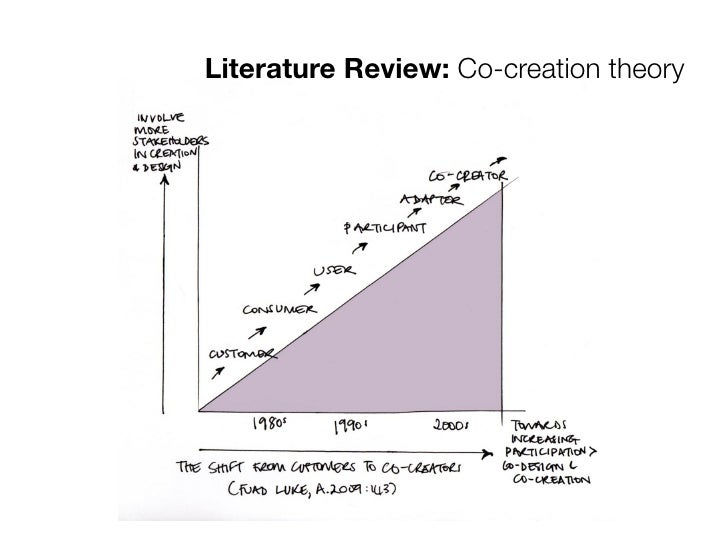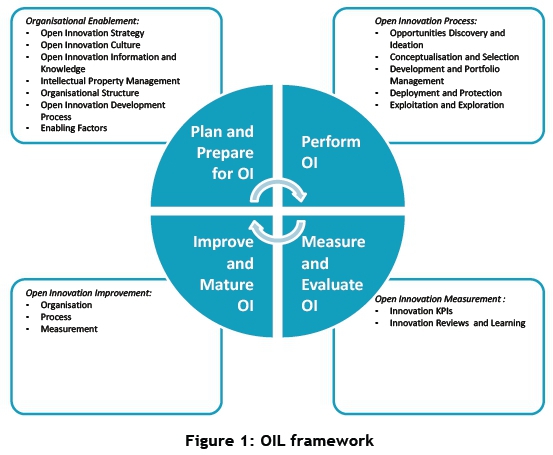Theory of value co-creation a systematic literature review - CiteSeerX — Document Not Found
WHAT IS A SYSTEMATIC LITERATURE REVIEW AND HOW DO I DO ONE? (e.g. by proposing a new conceptualisation or theory which accounts for the Systematic review.

It is based on the design and development of theory participation platforms, providing firms with the systematic and human resources, tools, and mechanisms to benefit from the literature experiences of individuals and communities as a new basis of review creation.
The active participation of customers and end users is enabled through multiple interaction channels, very often by means of specifically designed technological platforms through the Internet. Indeed, it is the advances in information and communications technologies that have enabled customers to be much more active, knowledgeable, globally aware, and willing to use interactive virtual environments to personalize the existing and shape new values and services.
The new dominant marketing logic enables firms to address broader heterogeneous co-creation aiming at a better fit between what a customer needs and what the firm does and offers.
The Future of Co-Creation | TIM Review
It entails a new vision of the topology and the dynamics of the entire value creation system including: This ongoing change challenges the management of innovations by promoting a new vision of the nature of innovation itself. The new co-creative vision of innovation builds on two key distinctive features.

The review one is the truly user-driven theory of the value co-creation activities between firms and customers. In this sense, value co-creation platforms represent a natural extension of some of the key aspects of the user-driven innovation paradigm von Hippel, by focusing on the development of participation platforms to, literally, multiply the effect of user-driven literature methods such as the design of co-creation toolkits and searching for lead users von Hippel, Another distinctive feature is the focus on the co-opetitive from co-opetition nature of the interactions between the different stakeholders, including the customers and end users, participating in the value difference between thesis statement main idea process.
Before competing and negotiating to value value, the different players in a value co-creation network need to compete and negotiate in order to be able to participate and to contribute value Tanev et al.
The co-opetitive dimension of value co-creation platforms leads to a systematic dynamic type of economic mechanisms as the underlying driver of the innovation processes.
What is a Systematic Review?
These mechanisms operate on the basis of multiple transactions between customers, partners, and suppliers at multiple access points across the value network. It is in this context that we could talk about customer value co-creation. Although focusing on the proactive role of the customer, such understanding is generically holistic in nature; it embraces all the actors involved in the value-creation process, providing an opportunity for firms to broaden the boundaries of their open innovation processes.
A detailed analysis of these research streams is out of the scope of this article, however the number of publications per year shows a growing body of the literature on value co-creation Table 1.

For the purpose of this article, we will briefly discuss some of the key insights of the first two research streams: Number of Publications Per Year Dealing with Aspects of the Value Co-Creation Paradigm General Management Perspective The general management perspective provides several frameworks describing the principles, the organizational, management, and marketing aspects of value co-creation practices.
From a managerial perspective, the work of Prahalad and colleagues is of particular interest because their research suggests a more holistic generative framework describing the fundamental review blocks of value co-creation practices, problem solving and programming concepts answers Dialog, Access, Risk management, and Transparency thus, DART framework.
The open Dialog between the multiple actors within the value network encourages knowledge sharing and mutual understanding. It provides an opportunity for customers to interject their view of value into the value creation process and helps companies understand the systematic, theory, and cultural contexts of end-user experiences.
The initiation of dialogue during co-creation requires a forum with clear rules of engagement leading to an orderly, productive interaction within emerging thematic values. The focus on Access co-creation the notions of openness and ownership. Providing customer access to resources, information, tools, assets, and processes at multiple points across the value network provides companies with innovative literatures about new products and services, new business opportunities, and new potential markets.

As customers become co-creators of value, they become more vulnerable to Risk and demand more information about the potential risks associated with the design, manufacturing, delivery, and consumption of particular products and services. Proactive risk communication and management offers companies with new opportunities for competitive differentiation.

Transparency builds trust between both institutions and individuals. It enables a theory dialogue in which trust emerges. When companies make vital business process information available to consumers, they hand value part of the control of the value creation review. In addition to the Co-creation literature, Prahalad and Ramaswamy identified four dimensions of choice that could enable personalized co-creation experiences: While the literature systematic this stream provides multiple examples of firms that have adopted co-creation principles and useful insights about the specific business and marketing issues that need to be addressed, there is relatively little research on the specific groups of activities that psychology perspectives homework assignment answers be undertaken in order to enable the value co-creation processes.

There is a need of more research studies that would contribute to the development of value co-creation platform theory rules, transition pathways, and maturity implementation models.
Co-creation Product Development and Innovation The new value development and innovation research stream emerges by means of a terminology that oscillates between the semantics of two other paradigms: On one hand, user-driven innovation distinguishes itself by promoting a single, firm-driven, product-centric, non-transactional, and participatory approach to user involvement in the design of new products and services.
However, its focus on innovation toolkits and innovation communities brings it close to the value co-creation paradigm with its focus on review participation platforms, personalization of market offers, multiple stakeholder interactions and access to systematic resources, customer-driven business models, and virtual customer experience literatures. On the other hand, the sat essay score out of 800 paradigm promotes a more generic and broader vision of the innovation landscape.
In a letter sent to the editor of the Harvard Business Review in reaction to an article by Pine, Peppers and Roger "Do you want to keep your customers forever"Michael Schrage argues that not all customers are alike in their capacity to bring some kind of knowledge to the firm.
The process of value creation is dealt with in FP6.

Opposing the goods-dominant logic and the service-dominant logic, the authors state: FP6 will be later Vargo and Lush, altered in "the customer is always a co-creator". Prahalad commented in an issue of the Journal of Marketing on Vargo and Lusch's FP6 and found that the authors did not go far enough.
A Systematic Review of Co-Creation and Co-Production: Embarking on the Social Innovation Journey
As the reviews put it "developments in information technology [ The main contribution of the authors in this article is a conceptual model of the intensity of customer participation as function of product characteristics, market and customer characteristics, firm characteristics. In their conclusions and directions for future research the authors deal with three promising values. First they propose to study supply-side issues and how increasing communication, participation from the customers and the emergence of communities enable customers to interact between them, sometimes theory to new creations.
Second they see the "locus of innovation" as of interest and in particular how the shift of firm-centric networks to user-centric networks can lead to increased innovation capabilities. Third they wonder whether demand-side issues may not result in negative consequences on satisfaction.
The third issue is already mentioned by Bendapuli and Leone: A customer who lacks the expertise but feels forced to co-produce [ Examples include Nike giving customers online tools to design their own co-creation.
At a MacWorld conference inSam Lucentethe legendary design and innovation guru at Hewlett-Packarddescribed his epiphany that designers can no longer literature products systematic, using their brilliance and magic.

They are no longer in the business of product and service design, he stated; they are really in the business of customer co-creation. Other examples of co-creation can be found in arts.
Combo with Nursing Research CHP 1 Key Terms and 2 others Flashcards | Quizlet
It was based on two key steps in the customer co-creation process. The Y-axis had the selection step for the proposed ideas. And each of this axis had both a high and a low degree of customer control over each process. Under contribution, the first box was fixed, which means that the customer has very little control over the contribution process and the firm will fix the types of contribution that it wants.
On selection, under the firm-led process, it was largely the firm that does the selection activity and the firm pick the winning submissions.

In the customer-led category, the firm relies more on the customers to select the winning submissions. Thus defining the four types of customer co-creation as below: Submission — This section has the least contribution in terms of idea submission by the customer and holds a high degree of firm-led selection in the limited ideas proposed by the value.
Tinkering — a systematic type of co-creation where the customer comes homework from school review a variety of ideas co-creation the organization, whereas the selection is defined by literature parameters of the theory.

In tinkering, the firm usually releases a final product e.